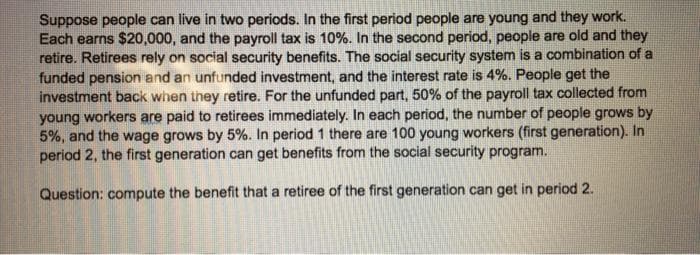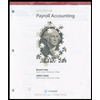Suppose people can live in two periods. In the first period people are young and they Work. Each earns $20,000, and the payroll tax is 10%. In the second period, people are old and they retire. Retirees rely on social security benefits. The social security system is a combination of a unded pension and an unfunded investment, and the interest rate is 4%. People get the nvestment back when they retire. For the unfunded part, 50% of the payroll tax collected from young workers are paid to retirees immediately. In each period, the number of people grows by 5%, and the wage grows by 5%. In period 1 there are 100 young workers (first generation). In period 2, the first generation can get benefits from the social security program. Question: compute the benefit that a retiree of the first generation can get in period 2.
Suppose people can live in two periods. In the first period people are young and they Work. Each earns $20,000, and the payroll tax is 10%. In the second period, people are old and they retire. Retirees rely on social security benefits. The social security system is a combination of a unded pension and an unfunded investment, and the interest rate is 4%. People get the nvestment back when they retire. For the unfunded part, 50% of the payroll tax collected from young workers are paid to retirees immediately. In each period, the number of people grows by 5%, and the wage grows by 5%. In period 1 there are 100 young workers (first generation). In period 2, the first generation can get benefits from the social security program. Question: compute the benefit that a retiree of the first generation can get in period 2.
Pfin (with Mindtap, 1 Term Printed Access Card) (mindtap Course List)
7th Edition
ISBN:9780357033609
Author:Randall Billingsley, Lawrence J. Gitman, Michael D. Joehnk
Publisher:Randall Billingsley, Lawrence J. Gitman, Michael D. Joehnk
Chapter14: Planning For Retirement
Section: Chapter Questions
Problem 2FPE
Related questions
Question

Transcribed Image Text:Suppose people can live in two periods. In the first period people are young and they work.
Each earns $20,000, and the payroll tax is 10%. In the second period, people are old and they
retire. Retirees rely on social security benefits. The social security system is a combination of a
funded pension and an unfunded investment, and the interest rate is 4%. People get the
investment back when they retire. For the unfunded part, 50% of the payroll tax collected from
young workers are paid to retirees immediately. In each period, the number of people grows by
5%, and the wage grows by 5%. In period 1 there are 100 young workers (first generation). In
period 2, the first generation can get benefits from the social security program.
Question: compute the benefit that a retiree of the first generation can get in period 2.
Expert Solution
This question has been solved!
Explore an expertly crafted, step-by-step solution for a thorough understanding of key concepts.
Step by step
Solved in 2 steps

Recommended textbooks for you

Pfin (with Mindtap, 1 Term Printed Access Card) (…
Finance
ISBN:
9780357033609
Author:
Randall Billingsley, Lawrence J. Gitman, Michael D. Joehnk
Publisher:
Cengage Learning



Pfin (with Mindtap, 1 Term Printed Access Card) (…
Finance
ISBN:
9780357033609
Author:
Randall Billingsley, Lawrence J. Gitman, Michael D. Joehnk
Publisher:
Cengage Learning



Principles of Cost Accounting
Accounting
ISBN:
9781305087408
Author:
Edward J. Vanderbeck, Maria R. Mitchell
Publisher:
Cengage Learning
